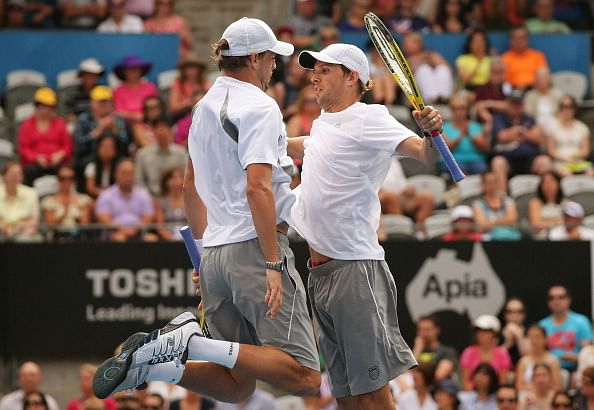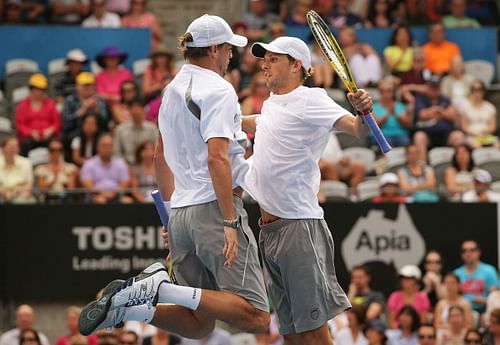
The doubles game: transition or termination?

When an Indian yearns for a fellow countryman’s name to light up on the scoreboard at a tennis match, seldom does he see a single name. Though rarely telecast, it is the doubles competition of the top events that features any Indian name. We see no top singles player today because long gone is the era of Krishnans and Amritrajs and quite ahead is the time when Indians could venture into the arena alone, sans a playing partner, and question the might of the Europeans and Americans.
Browsing through the ATP rankings this morning, a persistent ritual of any serious tennis fan come Monday, one could see that Mahesh Bhupathi jumped four spots to clinch the No. 6 position in the world and Rohan Bopanna retained his 11th rank after they reached the Rome finals.
This is nothing extraordinary or unusual. What amuses one on taking a closer look at the rankings is the fragile thread woven by the top 20 players. If yesterday, a 10th ranked singles player had lifted the trophy at Rome, he would hardly have risen by a rank or two. A similarly-ranked doubles player, on the other hand, could have catapulted into the top 5. Mahesh was ranked No. 10 but could manage a jump of four spots with a runner up finish, having had to defend semifinal points from the previous year.
It is rather disheartening to see the doubles game in a sorry condition today. Since the year began, only a few pairs have maintained their run of form and only the Bryans have managed to remain consistent, creating a gap of around 7000 points between them and the third ranked player. This is substantiated by their 6 titles this year including a Grand Slam and 3 Masters titles. The gap between the third ranked player and the fifteenth ranked player is just above 1000 points. Is the doubles game of tennis slackening? Perhaps.
Many reasons could be attributed to this downfall. The most valid and apposite one could be that the top doubles players are ageing. Tennis saw some of the greatest doubles players deluging the courts and amassing titles in the preceding decade and a half. Daniel Nestor, the Bryans, Max Mirnyi, Mark Knowles, Nenad Zimonjic, Mahesh Bhupathi, Leander Paes and others have graced the game in recent times. Most of them are now nearing the fag end of their illustrious careers. Some like Mark have decided to call it quits while others like Bhupathi are contemplating retirement. This rather debilitated bunch have failed to maintain their dominance and their powers no longer hold good.
Nestor and Bhupathi experimented with a new partnership by joining forces earlier this year but failed to create any impact. Fans grew rather worried as they had expected a good showing by the star pair and a decent swansong for the Indian ace. But they were practical enough to break up, and Bhupathi now wants to reinvent the magic of the New-Indian express. Nestor’s long time former partner Nenad Zimonjic managed a few good wins with Swede Robert Lindstedt and abruptly ended their partnership earlier this year. He is now partnering Julien Benneteau while Robert joined forces with Nestor.
Though tennis is an individual sport, the doubles game requires two different individuals to bond well, reconciling their differences and blending their games on court to create a winning combo. This season has seen almost all top players change their doubles partners. Nestor discounted Mirnyi because he was sceptical about his injuries, Mahesh ended his blossoming partnership with Bopanna saying that their aim was only the Olympics. Stepanek had injuries which made Paes partner Jurgen Melzer, although now he is back on court, while two time Wimbledon finalists Robert Lindstedt and Horia Tecau parted ways too. There was further reorganisation with Nestor-Bhupathi, Zimonjic-Lindstedt and others breaking up prior to the year’s second Grand Slam. If one cannot grasp the importance of a good partner and a good partnership, think of Lukas Dlouhy who, after ending his long term partnership with Paes, plummeted down the rankings ladder from the top echelons of the rankings chart and is now struggling to remain in the top 100.
Perhaps the new pairings are yet to gain momentum. Almost all the top players have opted for different partners from those that they partnered last year. Could this mean that the doubles game’s standard has fallen and its revival is not easy? Perhaps. To bring about a revival, a new bunch of players have to come up and dominate, stepping on to the shoes of theirs seniors. Bopanna, Qureshi, Rojer, Marc Lopez, Marcel Granollers, Horia Tecau and the likes possess ample talent, which when streamlined properly could translate into a more competitive and vibrant era in doubles play.
An even more satisfying explanation to this situation could be that the game of tennis has evolved in such a manner that it has become more demanding and physical. This is something new to the doubles specialists who at their age would find it difficult to incorporate changes in their regimen. This is perhaps the chance for a few young pairs to sprout. Spain has gained a lot by not only having a well experienced pair in Lopez-Granollers but also an upcoming and strong pair in Fernando Verdasco and David Marrero.
The re-advent of singles players into doubles play could signal the start of a new era. But how far those singles players would be able to concentrate on doubles is unknown. Granollers expressed his happiness at being able to play well in both the formats and at being able to adapt to a situation wherein he might even have to play two matches everyday. Still, there is a long way to go before doubles play allures more fans, but there remains a short period before today’s masters bid farewell to their beloved courts and their favourite weapons – the racquet and ball.
Perhaps no one would like to equate a Nestor or the Bryans to Federer or Nadal. The doubles game has, for long, been the unwanted child of tennis. The step-motherly treatment meted out so far needs to change. Higher prize money, if not equal to that of singles, could allure more youngsters to focus on doubles. If top singles players too participated in doubles events, the way the women do, it would translate to adding a layer of cream to the cream-starved cake called ‘Doubles’ and that in turn would attract people to devour the cake.